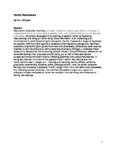Feeling redundancy
| dc.contributor.author | Simpson, Paul | |
| dc.date.accessioned | 2022-02-14T10:25:39Z | |
| dc.date.available | 2022-02-14T10:25:39Z | |
| dc.date.issued | 2021-12-02 | |
| dc.identifier.issn | 0016-7398 | |
| dc.identifier.issn | 1475-4959 | |
| dc.identifier.uri | http://hdl.handle.net/10026.1/18765 | |
| dc.description.abstract |
<jats:title>Abstract</jats:title><jats:p>Redundant. Adjective meaning: no longer needed or useful; superfluous; no longer in employment due to no more work available; able to be omitted without loss of meaning or function; not strictly necessary to functioning of system/other components. Redundancy, and being at risk of being made redundant, is an increasingly felt circumstance in contemporary higher education. As the impacts of a range of neoliberal educational reforms unfold against a backdrop of demographic change and significant economic uncertainty (both pandemic‐driven and otherwise), universities have recently resorted to both voluntary and compulsory redundancy to manage a university model based on a competitive and fluctuating student market. This commentary reflects on the collective feelings that circulated around being put “at risk” of redundancy and subsequent encounters with others’ unfolding (potential and actual) redundancy. In doing so, attention is turned to the spaces‐times in which redundancy and the “consultations” over it played out – meeting and teaching rooms, offices, corridors, graduation ceremonies, kitchens, cafes, among others – and the varied collective feelings that circulated/coexisted in and through them. At a time when such processes are unfolding across the sector, this commentary seeks to open up a space for reflection on what many would rather not consider: the disturbing circumstances of feeling redundancy.</jats:p> | |
| dc.format.extent | 125-131 | |
| dc.language | en | |
| dc.language.iso | en | |
| dc.publisher | Wiley | |
| dc.subject | affect | |
| dc.subject | atmosphere | |
| dc.subject | feeling | |
| dc.subject | higher education | |
| dc.subject | redundancy | |
| dc.title | Feeling redundancy | |
| dc.type | journal-article | |
| dc.type | Note | |
| dc.type | Journal | |
| plymouth.author-url | https://www.webofscience.com/api/gateway?GWVersion=2&SrcApp=PARTNER_APP&SrcAuth=LinksAMR&KeyUT=WOS:000724769200001&DestLinkType=FullRecord&DestApp=ALL_WOS&UsrCustomerID=11bb513d99f797142bcfeffcc58ea008 | |
| plymouth.issue | 1 | |
| plymouth.volume | 188 | |
| plymouth.publication-status | Published | |
| plymouth.journal | The Geographical Journal | |
| dc.identifier.doi | 10.1111/geoj.12425 | |
| plymouth.organisational-group | /Plymouth | |
| plymouth.organisational-group | /Plymouth/Faculty of Science and Engineering | |
| plymouth.organisational-group | /Plymouth/Faculty of Science and Engineering/School of Geography, Earth and Environmental Sciences | |
| plymouth.organisational-group | /Plymouth/REF 2021 Researchers by UoA | |
| plymouth.organisational-group | /Plymouth/REF 2021 Researchers by UoA/UoA14 Geography and Environmental Studies | |
| plymouth.organisational-group | /Plymouth/Users by role | |
| plymouth.organisational-group | /Plymouth/Users by role/Academics | |
| dcterms.dateAccepted | 2021-11-03 | |
| dc.rights.embargodate | 2022-9-8 | |
| dc.identifier.eissn | 1475-4959 | |
| rioxxterms.versionofrecord | 10.1111/geoj.12425 | |
| rioxxterms.licenseref.uri | http://www.rioxx.net/licenses/all-rights-reserved | |
| rioxxterms.licenseref.startdate | 2021-12-02 | |
| rioxxterms.type | Journal Article/Review |


